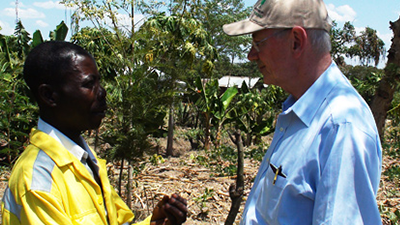Africa’s first agricultural soil carbon project changes Kenyan lives. Tom Odhiambo and Maurice Kwadha are small-scale farmers in western Kenya, and they understand all too well the impact of climate change on their local environment and food production. On just one acre of land inherited from his father, Tom and his wife Mary practice improved agricultural practices, which have enabled them to increase yields and make more money than other smallholder farmers in this hot and dry environment.
Andrew Steer, the World Bank’s Special Envoy on Climate Change, witnessed firsthand how “climate smart” agriculture is transforming small scale farming and improving the livelihoods of poor farmers, thanks to the support of the World Bank’s BioCarbon Fund (BioCF) and Africa Region.
"These farmers have adopted new farming techniques and as a result are benefiting from a triple win in agriculture," said Steer during a field visit to Kisumu near Lake Victoria. "They are getting higher yields, improving the resilience of their crops to drought and creating stronger soils that sequester more carbon."
Steer recently spent a day at the site of an agricultural soil carbon project in Kombewa in the outskirts of Kisumu. He was accompanied by Patrick Verkooijen, the Bank’s new coordinator for climate-smart agriculture, the World Bank’s regional focal point Johannes Woelcke and Bo Lager, the project coordinator of SCC-Vi Agroforestry— the Swedish Cooperative which is implementing the project.
Odhiambo and Kwadha are among 60,000 farmers in the Kisumu and Kitale regions participating in the first agricultural soil carbon project in the world supported by the BioCF and -Vi Agroforestry.
"This land was bare beforehand, but with support of this project I have improved it through mulching, inter-cropping and application of manure," said Odhiambo, who has a remarkable mix of maize, bean, groundnuts, bananas, sweet potatoes and cassava on this small plot of land. He also has planted trees on the edges of his "shamba," which provide fodder for his one cow, act as wind-breakers and when mature, will provide both firewood and fencing poles. The project demonstrates that there is significant potential to support Africa’s agriculture and rural development through the "triple-win" of increased productivity, enhanced climate resilience and greenhouse gas mitigation.


